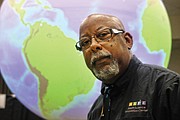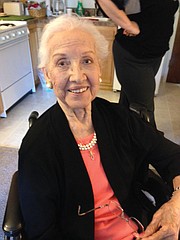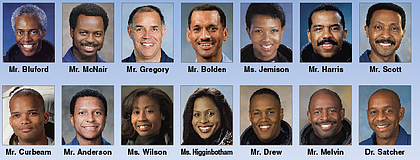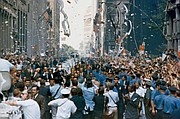Moon memories: Reflections on Apollo 11 on 50th anniversary of historic landing
George Copeland | 7/19/2019, 6 a.m.
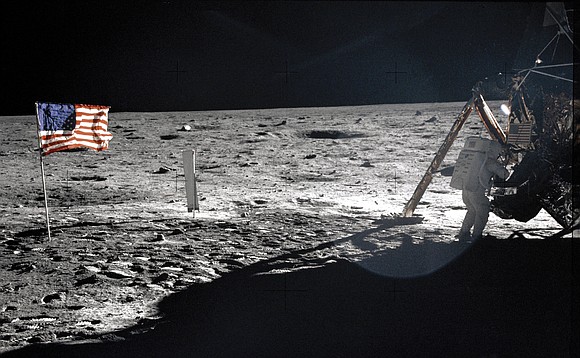
Dr. Carroll H. Ellis Jr. remembers Apollo 11 vividly.
Though he was only 14 years old on July 20, 1969, the geoscientist can still recall the excitement 50 years ago when American astronauts landed on the moon and took their first steps. The technical skill it took then is impressive even to this day.
“It just hasn’t been anything like that since,” said Dr. Ellis, who works at the MathScience Innovation Center in Henrico County. “That was the only thing that anyone talked about. It was an American that made the landing, but it was a success for humanity.
“Even now, it’s hard for me to believe that 1950s and ’60s technology got us to the moon, whereas, now, one cell phone has more computing power than all the entire rooms of NASA computers at that time. And they were still able to make this thing happen,” he said.
The day is just as clear to Joylette Hylick, daughter of famed NASA mathematician Katherine G. Johnson, whose calculations, along with the work of scores of others at NASA, were critical to Apollo 11’s success.
Now 100 and still residing in Hampton Roads, Mrs. Johnson began working with NASA in Hampton with a few other African-American women in 1953, when it was called the National Advisory Committee for Aeronautics. Her influence on space travel, which stretched from America’s first manned flight by Mercury astronaut Alan B. Shepard in 1961 to Apollo 11’s moon landing to the start of the Space Shuttle program, was immortalized in the book and blockbuster film, “Hidden Figures.”
For Ms. Hylick, who lives in Mount Laurel, N.J., this week’s anniversary and celebration of the lunar landing calls up memories of extensive media coverage, an energized Newport News community and a mother cooly confident in her role of what would become history.
“She said, ‘If they did what we told them, they will be fine,’ ” Ms. Hylick recalled. “And she felt that that would be the case.” Mrs. Johnson, who was attending an Alpha Kappa Alpha Sorority convention in Pennsylvania, paused with the rest of the nation to watch the television broadcast of Neil Armstrong and Buzz Aldrin walking on the moon’s surface.
“Everything she did, she thought was normal. Everybody else thought it was extraordinary,” Ms. Hylick said.
The differences and commonalities in Dr. Ellis’ and Ms. Hylick’s recollections speak to the effect the Apollo 11 mission had on the world. That impact has grown in recent years, with greater attention brought to women of color involved in the sciences, mathematics and the space program because of “Hidden Figures.” Ms. Hylick is well aware of this effect. She has traveled frequently — often alongside her mother — in the years following the movie’s 2016 release to a White House ceremony, university commencements and building dedications honoring her mother. In addition to receiving several honorary degrees, Mrs. Johnson was awarded the Presidential Medal of Freedom in November 2015 by President Barack Obama. She also has had several buildings named after her, including the largest building on George Mason University’s science campus in Northern Virginia, NASA’s sole facility in Mrs. Johnson’s native West Virginia and a statue and scholarship at West Virginia State University, Mrs. Johnson’s undergraduate alma mater.
Dr. Ellis and the MathScience Innovation Center were an active part of the movie’s initial premiere in Richmond, hoping to use the interest surrounding it as a platform to encourage greater involvement in the sciences among African-Americans. But Dr. Ellis admits there have been challenges.
Ms. Hylick pointed to the messages sent to Mrs. Johnson from schoolchildren in Quebec, to a teary-eyed encounter with a black scientist at NASA and close relationships with astronauts including Yvonne Cagle, an African-American, as evidence of the importance her mother and other women of color still hold for younger generations.
That legacy potentially could be bolstered by “Reaching for the Moon,” a newly released autobiography by Mrs. Johnson, and one that breaks from written works with a similar focus by its depth of authenticity and Johnson family involvement. When she was asked about her mother’s history, Ms. Hylick responded simply, “We just said she lived a normal life. She was just a very curious child with parents who supported it. Hopefully (the book) will answer a lot of questions that people have and provide more insight.”
Still, Ms. Hylick and Dr. Ellis question whether the field of space science has become more inclusive since Mrs. Johnson’s days at NASA, though both see the importance of aspirational scientific figures for young people of color.
“It’s important that young people see themselves and know that, ‘Hey, it is possible for me to do this because this guy has done it, this woman has done it,’ ” Dr. Ellis said.
Ms. Hylick said she has spoken to scientific figures and officials in private about broadening the range of people they employ, noting that “diversity gives you a wider range of information more knowledge, more ideas, because we have some smart people. It’s just that they aren’t given the opportunity.”
Since the Apollo 11 landing in 1969, 14 African-American astronauts have gone into space. Other African-American scientists, engineers, mathematicians and specialists have worked on NASA projects, although the numbers are unknown.
Still, this uncertainty exists at a time of big promises and changes that could alter the future of NASA specifically and space science in general. As NASA continues to analyze the solar system, the Trump administration has expressed interest in projects ranging from a Space division of the U.S. military, manned missions to Mars and permanent outposts on the moon, while other countries from Russia to Japan continue to expand their space programs.
“We’re not the only game in town when it comes to space,” Dr. Ellis said. “There are quite a few other nations that have successful programs.”
With a decrease in manned missions over the years and the rising cost of developing technology, Dr. Ellis sees the futureof space science being determined by projects and companies like Blue Origin, SpaceX and Virgin Galactic that have set their sights on a range of goals, from reusable spacecraft to commercial space travel.
Given the intersections and interdependencies between the public and private entities that already exist in places like the International Space Station, Dr. Ellis characterizes these recent moves as part of “this giant effort to make it less expensive to travel into space, and broaden it so more people and companies and entities can get into it.”
Regardless of whether public support or private interest directs the course of space science, it will all be following the example set by Apollo 11 and the people that ensured its success.
Ms. Hylick recalled a ceremony where Mrs. Johnson received a top award from the Institute of Electrical and Electronics Engineers. Of the 24 mostly white people who were honored that night, Ms. Hylick said, “Mama was the only one that got a standing ovation. And she wasn’t even an engineer.”
African-American astronauts among the stars
Here’s a list of African-American astronauts who have traveled into space.
The date of their first mission into space is listed:
• Guion Bluford: Aug. 30, 1983; the first African-American in space and the first African-American shuttle mission specialist.
• Ronald McNair: Feb. 3, 1984; nationally recognized for his work in laser physics; killed with six other crew members in the Space Shuttle Challenger explosion seconds after takeoff on Jan. 28, 1986.
• Frederick D. Gregory: April 29, 1985; first African-American Space Shuttle pilot and mission commander in 1989; and the first African-American to become acting administrator of NASA in 2005.
• Charles Bolden: Jan. 12, 1986; first permanent African-American NASA administrator from 2009 to 2017.
• Mae Carol Jemison: Sept. 12, 1992; first African-American woman in space.
• Bernard Anthony Harris Jr.: April 26, 1993; first African-American to walk in space.
• Winston E. Scott: Jan. 11, 1996; veteran of three spacewalks; former director of the Florida Space Authority.
• Robert Curbeam: Aug. 7, 1997; veteran of seven spacewalks and overall record holder.
• Michael P. Anderson: Jan. 22, 1998; logged more than 593 hours in space; killed with six other crew members in the Space Shuttle Columbia disaster upon re-entry on Feb. 1, 2003.
• Stephanie D. Wilson: July 4, 2006; part of the first shuttle flight after the Columbia disaster; spent 42 days in space, the most of any African-American astronaut.
• Joan Higginbotham: Dec. 9, 2006; logged more than 308 hours in space.
• Alvin Drew: Aug. 8, 2007; the 200th person to walk in space on Feb. 28, 2011; veteran of two spacewalks.
• Leland D. Melvin: Feb. 7, 2008; the Lynchburg, Va., native logged morethan 565 hours in space. He went to the University of Richmond on a football scholarship, graduating with a chemistry degree, and later earned a master’s from the University of Virginia.
• Robert Satcher: Nov. 16, 2009; more than 259 hours logged in space; a surgeon and and engineer, this Hampton, Va., native is a former Schweitzer Fellow at the Albert Schweitzer Hospital in Lambaréné, Gabon.
Sources: US Black Engineer magazine, Wikipedia
Area commemorations
Several events will be held in the Richmond area this Saturday and beyond to mark the 50th anniversary of the Apollo 11 mission to the moon. They include:
Science Museum of Virginia, 2500 W. Broad St.
The Science Museum of Virginia is hosting Science After Dark: Moon Landing, 5 to 9 p.m. Friday, July 19, at the museum, with hands-on moon-themed activities, including green screen photos of attendees on the moon and Friendship 7 parachutes. Activities for youngsters also include making straw rockets launched with a puff of air and free episodes of the PBS Kids series, “Ready Jet Go!” Museum displays also feature space-related artifacts, including a moon rock, a fragment of a 6.5 pound piece of high-titanium basalt brought back from the 1972 Apollo 17 mission, the last of NASA’s Apollo program. Astronomy shows in the museum’s Dome theater will take place at 6:30 and 7:15 p.m., and an episode of the PBS documentary, “Chasing the Moon,” at 8 p.m. Members of the Richmond Astronomical Society will be on the front lawn with telescopes for stargazing. Cost: $10; museum members and children age 2 and younger are free.
Activities continue on Saturday, July 20, with the museum’s Moon Landing Anniversary featuring additional hands-on activities, including learning about space food preparation and recipes. “Imagine the Moon,” a new astronomy show will be shown in the Dome at 11 a.m. and 1 and 3 p.m., which are free with museum admission. A special showing of the 1995 film, “Apollo 13,” will take place at 4 p.m. in the Dome. Tickets, which are $4, are required. Museum admission: $15 for adults; $13.50 for seniors and youths; $10 for ages 3 through 5; free for children ages 2 and under and museum members. Details: http://www.smv.org">www.smv.org or (804) 864-1400.
The Richmond Flying Squirrels at The Diamond, 2001 N. Arthur Ashe Blvd.
The Flying Squirrels are holding a Lunar Landing Night Celebration and Astronaut Jersey Auction Saturday, July 20, at The Diamond, when the Squirrels take on the Erie SeaWolves of Pennsylvania. Gates open at 5 p.m.; game starts at 6:05 p.m. Team members will wear special spacesuit jerseys inspired by the ones worn by Apollo 11 astronauts Neil Armstrong, Buzz Aldrin and Michael Collins. The jerseys will be auctioned during the game, with proceeds benefiting the MathScience Innovation Center. The first 1,000 fans ages 15 and older will receive a free astronaut-themed bobblehead. Fireworks will blast off after the game. Tickets: $8 Details: http://www.squirrel…">squirrelsbaseball.c… or (804) 359-FUNN.
Virginia Museum of History & Culture, 428 N. Arthur Ashe Blvd.
The museum and WCVE PBS will present “An Evening With Margot Lee Shetterly,” author of the book, “Hidden Figures,” at 6 p.m. Thursday, Aug. 8, at the museum. Ms. Shetterly will be joined by Dr. Gladys West, a Dinwiddie County native, whose work at the Dahlgren Naval Support Facility in Virginia became the basis for the GPS systems people now depend on. Tickets: $30; $20 for museum members. Details:virginiahistory.org"> virginiahistory.org or (804) 342-9656.

